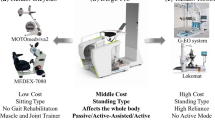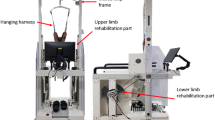Abstract
This paper describes a gait training algorithm based on the inverse dynamics of DDgo Pro, an end-effector-type walking rehabilitation robot. As a major feature, a gait training algorithm with high responsiveness and flexibility was achieved by analyzing the inverse dynamics of the five-link mechanism with a foothold attached to the end of the mechanism and compensating for the required torque for the link motion and the patient’s weight during gait training. To this end, inverse dynamics was solved using Newton Euler’s method, and three training modes were proposed. First, passive mode training performs three tasks: motion compensation of the five-link mechanism for the given constant walking speed through the inverse dynamics, patient’s weight compensation, and tracking of the gait trajectory of the foothold using PD control to practice the normal walking pattern and restore muscle strength for standing. Second, Active-assisted mode training was implemented for the patient to receive muscle assistance from an electric motor in proportion to the patient’s walking intention in addition to the reduced compensations of the motion of the five-link mechanism and patient’s weight. Third, active mode training was implemented so that the patient can perform gait training while feeling their own weight with the time-varying motion compensation of the five-link mechanism. Finally, the performance of each gait training mode was experimentally verified, and the muscle activity was measured using EMG sensors to compare the muscle assistance performances of the training modes. Furthermore, the correction of the gait motion of the affected leg according to the motor assistance in active-assisted mode was also verified.





















Similar content being viewed by others
References
Garcia E, Jimenez MA, De Santos PG, Armada M (2007) The evolution of robotics research. IEEE Robot Autom Mag 14(1):90–103
Song WK (2016) Trends in rehabilitation robots and their translational research in National Rehabilitation Center, Korea. Biomed Eng Lett 6:1–9
Centers for Disease Control and Prevention (2003) Trends in aging—United States and worldwide. MMWR Morb Mortal Wkly Rep 52(6):101–104, 106
Park SY (2015) The effects of robot-assisted gait training for the patient with post stroke: a meta-analysis. KAUTPT 22(2):30–40
Jung KH, Ha HG, Shin HJ et al (2008) Effects of robot-assisted gait therapy on locomotor recovery in stroke patients. J Korean Acad Rehabil Med 32(3):258–266
Chang MC, Chun MH (2015) Use of robots in rehabilitative treatment. J Korean Med Assoc 58(2):141–146
Israel JF, Campbell DD, Kahn JH, Hornby TG (2006) Metabolic costs and muscle activity patterns during robotic- and therapist-assisted treadmill walking in Individuals with incomplete spinal cord injury. Phys Ther 86(11):1466–1478
Marchal-Crespo L, Reinkensmeyer DJ (2009) Review of control strategies for robotic movement training after neurologic injury. J Neuro Eng Rehabil 6:20
Zhang X, Yue Z, Wang J (2017) Robotics in lower-limb rehabilitation after stroke. Behav Neurol 2017:1–13
Cao J, Xie SQ, Das R, Zhu GL (2014) Control strategies for effective robot assisted gait rehabilitation: the state of art and future prospects. Med Eng Phys 36(12):1555–1566
Riener R, Lünenburger L, Jezernik S et al (2005) Patient-cooperative strategies for robot-aided treadmill training: first experimental results. IEEE Trans Neural Syst Rehabil Eng 13(3):380–394
Bernhardt M, Frey M, Colombo G, Riener R (2005) Hybrid force-position control yields cooperative behavior of the rehabilitation robot LOKOMAT. In: 9th international conference on rehabilitation robotics, Chicago, IL, pp 536–539
Mirzaei A, Ozgoli S (2011) A new impedance control structure for leg rehabilitation robot. In: The 2nd international conference on control, instrumentation and automation, pp 952-956. Shiraz, Iran
Tufekciler N, Van Asseldonk EHF, van der Kooij H (2011) Velocity-dependent reference trajectory generation for the LOPES gait training robot. 2011 IEEE international conference on rehabilitation robotics. Zurich, Switzerland, pp 1–5
Tran QV, Kim S, Lee K, Kang S, Ryu J (2015) Force/torque sensorless impedance control for indirect driven robot-aided gait rehabilitation system. 2015 IEEE international conference on advanced intelligent mechatronics (AIM). Busan, Korea, pp 652–657
Hussein S, Schmidt H, Kruger J (2009) Adaptive control of an end-effector based electromechanical gait rehabilitation device. 2009 IEEE international conference on rehabilitation robotics. Kyoto, Japan, pp 366–371
Mehrholz J, Wagner K, Rutte K et al (2007) Predictive validity and responsiveness of the functional ambulation category in hemiparetic patients after stroke. Arch Phys Med Rehabil 88(10):1314–1319
Kim JY, Kim JY, Kim HS, Park K (2020) Development and evaluation of a hybrid walking rehabilitation robot, DDgo Pro. Int J Precis Eng Manuf 21:2105–2215
Kim JY, Kim JY (2020) Gait training algorithm based on inverse dynamics of walking rehabilitation robot, DDgo Pro. https://youtu.be/AY8eiaZwY9s
Won JI (2006) The effect of muscle strengthening exercise and gait training for stroke persons in a community. Phys Ther Korea 13(3):18–23
Griffin MP, Olney SJ, McBride ID (1995) Role of symmetry in gait performance of stroke subjects with hemiplegia. Gait Posture 3(3):132–142
Acknowledgements
This work was supported by Korea Institute for Advancement of Technology (KIAT) grant funded by the Korea Government (MOTIE) (P0008473, HRD Program for Industrial Innovation) (IRB No. NRC-2019-03-014). In addition, this work was also supported by HUCASYSTEM, Inc.
Author information
Authors and Affiliations
Corresponding author
Additional information
Publisher's Note
Springer Nature remains neutral with regard to jurisdictional claims in published maps and institutional affiliations.
Supplementary Information
Below is the link to the electronic supplementary material.
Supplementary file 1 (WMV 111293 KB)
Rights and permissions
About this article
Cite this article
Kim, JY., Kim, JY. Gait training algorithm based on inverse dynamics of walking rehabilitation robot, DDgo Pro. Intel Serv Robotics 14, 143–155 (2021). https://doi.org/10.1007/s11370-021-00357-8
Received:
Accepted:
Published:
Issue Date:
DOI: https://doi.org/10.1007/s11370-021-00357-8




